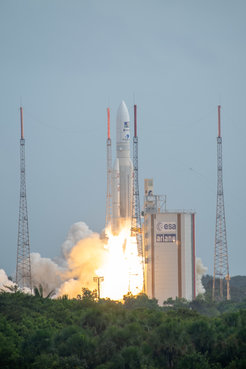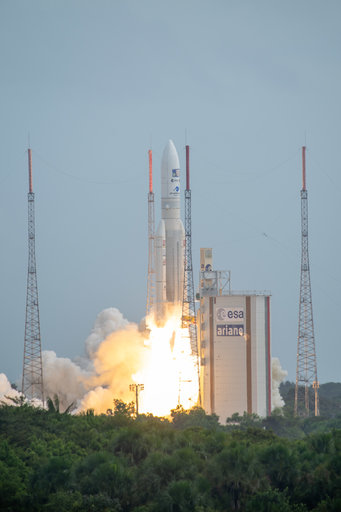JUICE embarks on its journey to Jupiter
The launch was successful; the ESA’s space probe JUICE is now on its way to the Jupiter system. There, it will primarily study the gas giant's icy moons.
After a one-day delay, the Ariane 5 rocket with ESA's JUICE (Jupiter Icy Moons Explorer) spacecraft on board lifted off today at 2:14 pm (CEST) from the Guiana Space Center in South America. Due to the threat of thunderstorms, the coutdown had to be canceled yesterday. Today, the start of the eight-year journey to Jupiter went according to plan: 79 minutes after lift-off, the spacecraft had already separated from the rocket and reported to the control center that the solar panels had been successfully deployed. The Max Planck Institute for Solar System Research (MPS) in Göttingen is sending two scientific instruments on the adventurous expedition to the Jupiter system.

"Today is a very special day for us," said MPS Director Prof. Dr. Thorsten Kleine, who heads the Institute's Planetary Science Department. "We are very happy that after years of preparations JUICE is now on its way," he added.
The MPS has been a partner in the JUICE mission since the beginning. For example, MPS scientists contributed to the precise design of the science objectives during the mission's planning phase 18 years ago. "In recent years, more than 50 scientific and technical staff members at MPS have developed, built, and tested hardware for our JUICE instruments with passion, dedication, skill and expertise," Kleine said.
One of these instruments is the Submillimetre Wave Instrument (SWI). It was created under the direction of the MPS and will be operated by the MPS during the mission. In the Jupiter system, SWI will study the thermal radiation emitted into space by the gas giant and its icy moons. Among other things, this contains information about the composition of the atmospheres and surfaces, wind speeds and thermophysical properties. In addition, the MPS contributed one of a total of six sensors to the Particle Environment Package (PEP). Unlike SWI, PEP is an in situ instrument: it measures the energetic particles flowing around the spacecraft in the Jupiter system. Among other things, this allows conclusions to be drawn about the magnetosphere of the gas giant and the composition of the thin exospheres of the icy moons.
The researchers are particularly interested in the question of the life-friendliness of Jupiter's large moons Europa, Ganymede, and Callisto. It is known from previous space missions that liquid oceans extend beneath their thick ice crusts. But do they provide other conditions besides liquid water that are necessary for the emergence of life?
In addition to some essential elements, such as carbon, hydrogen, nitrogen, oxygen, phosphorus, and sulfur, there would have to be a source of energy inside the moons that could set the necessary processes in motion. "Ganymede is a particular focus for JUICE", MPS scientist Dr. Norbert Krupp of the PEP team explained. Ganymede's inner ocean is up to 800 kilometers deep and has a layered structure of liquid water and ice. Salts could be dissolved at the boundary layers, which are necessary to drive energy-giving chemical reactions in the ocean. "It is also important to know more about the radiation in the immediate vicinity of these moons. This will help us better understand their formation and activity," Krupp said. As ice particles are repeatedly ejected into space from the ice crust, JUICE instruments will have direct access to the surface and possibly the oceans.
However, for now, patience is required until JUICE arrives in the Jupiter system; the journey takes about eight years. To build up the necessary momentum, three flybys of Earth and one of Venus are planned during this time. For the employees at the MPS, however, the time should not be long. During the so-called flyby maneuvers, the scientific instruments will be switched on. And the commissioning of the instruments is already on the mission calendar for the coming weeks and months. Then SWI and PEP will have to prove that they also work under space conditions. The adventure has begun.












